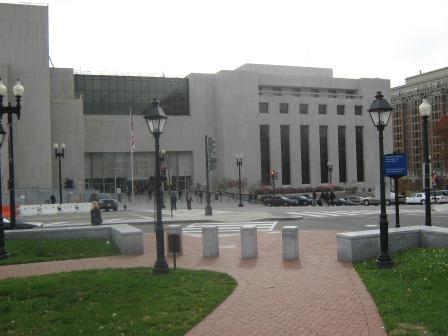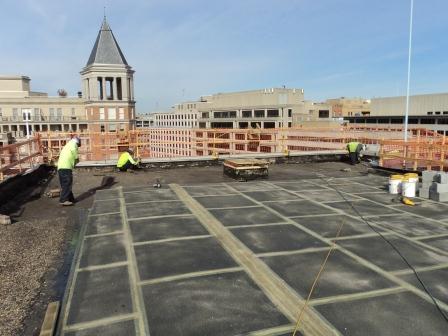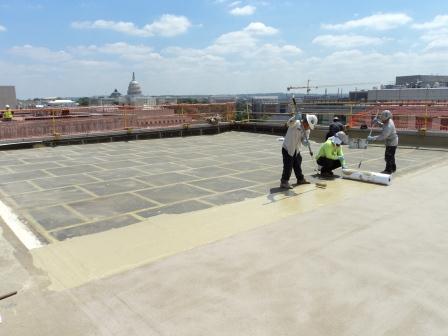Washington, D.C., is known across the country for many things, austere buildings being one of them. But not all of the buildings are created equal. And when the H. Carl Moultrie Courthouse, home to D.C's Superior Court, needed a few upgrades, the crew from Tecta America came in to help. For the courthouse, that meant trying to balance the construction of a new roof while working with the occupants — U.S. Marshals — as well as the 10,000+ visitors per day. A trial in and of itself!

Court Dismissal
In less than a year, the eight-to-ten-man Tecta crew worked the courthouse roof in stages. The first step was to remove the existing roof: a built-up roof (BUR) with isocyanurate insulation and a fiberboard cover board. Although the previous roof seemed to be in decent shape, the building managers had recently installed four new ventilation systems to pressurize the stairwells for fire proofing (one on each wing), as well as new duct work on the roof, which added a few new penetrations to the rooftop.
Using a Garlock roof cutter, the Tecta crew removed the 80,000-square-foot (7,432 m²) roof in 1,500 to 1,800 square-foot (139–167 m²) sections and dumped it into a truck on the ground using a Grove 60-ton (54,431 kg) RT crane and a dump pan. The crew worked in sections, starting on the west wing and moving to the east wing. Remove a section and immediately replace it with isocyanurate insulation board (used to insulate and create positive drainage), concrete board, and KEMPERTEC EP primer. That was Tecta’s method to ensure that no part of the roof was uncovered overnight. You never know when a summer storm might hit in the nation’s capital! “We only tear off what we can do in one day, and then we recover it the same day with the Kemper System  so it stays watertight,” said Project Manager Paul Dubics of Tecta America.
so it stays watertight,” said Project Manager Paul Dubics of Tecta America.
Once the crew had cleaned that day’s section of old roof off using a crane with skid pans and netting, they worked to clean it up to prepare it for the new Kemper system. That meant removing all of the excess asphalt left behind and grinding any metal substrates. Using a diamond blade on a six-inch (15 cm) grinder and a wire brush attachment on a drill, the Tecta crew made sure that there were no foreign materials left behind on the metal substrates (including the penetrations from the new stairwell ducts) or concrete surfaces that the Kemper product would come in contact with. The crew had to give particular attention to the perimeter of the rooftop walls where the flashing and asphalt came together. “We had to grind the concrete down…to adhere the Kemper directly to the concrete rather than a foreign substance, which would cut loose over the years,” explained Tecta’s General Superintendent Michael Gaulin. They removed tar and urethane in addition to the old system, anything that would have inhibited the crew from tying the new roof system into the concrete rooftop.
The Jury’s In!
The new installation for the roof of the courthouse, originally completed in 1976, was the KEMPEROL 2K-PUR. Starting from the bottom, the Kemper system included polyiso insulation, cement board, the liquid primer, a polyurethane resin, polyester fleece, two more layers of the polyurethane resin, and finally a white epoxy topcoat.
After each section was primed, the crew came in the next day to roller-apply the pancake-batter-like resin in three-foot-wide (0.9 m) areas. Into the resin, which was applied at 4.5 gallons (17 L) per 100 square feet (9 m²), the crew came in and set the 70-mil (1,778 microns) re-enforcing fleece fabric. The crew rolled this layer on with ? to ½ inch (0.9–1 cm) rollers to rid the system of any potential air pockets. “You make sure you get all the air pockets out first and then you come behind and make sure that all parts of mesh are covered,” explained Gaulin. The crew roller-applied a second layer of resin at 2 gallons (8 L) per 100 square feet (9 m²) “to totally saturate the reinforcing fleece with the resin.” The fleece is used to help control the thickness of the membrane and add reinforcement to the resin.

In the typical Kemperol 2K-PUR system, this is where the gavel goes down. However, the courts decided to add another layer of resin on top, which received a cascade of sand to help with anti-slip properties. Once the surface was covered in sand and the coating was cured, the crew came in and swept up any loose particles. Finally, the water-based white reflective topcoat, Kemperdur BSF-R Finish, was roller-applied at 110 square feet per gallon (4,482 m²/L).
Trials and Tribulations
As the largest building on Judiciary Square, the seven-story structure acts as the headquarters for the U.S. Marshal Service. For the Tecta crew, that meant working around a few challenges that most coatings jobs do not entail.
The first, perhaps not surprising to many city slickers, was the difficulty finding parking on the D.C. streets. “D.C.’s not bad as long as they give you some room to park your truck,” explained Gaulin. Lucky for him, the building managers gave the Tecta crew a staging area to park their vehicles…on a very specific schedule. Taking up the spots of federal marshals doesn’t go over well unless there’s a clear-cut expectation set out beforehand. “For us to bring in tractor trailers of insulation, we needed to give them a minimum of two weeks’ [notice]. We tried to maximize our delivery to the best that we could.” For the Tecta crew, maximizing their deliveries with four deliveries of insulation for both the east and west wings meant coordination, coordination, coordination.
Other concerns for the courthouse occupants were odor and noise. Luckily, the Kemper system is odorless. It didn’t hurt that the building also had few air intakes to circulate any air from the roof into the building. As for the noise: “The east building on the sixth floor housed the judges’ chambers, so when we got over to those areas we worked on weekends when they weren’t around,” said Gaulin. If they couldn’t do work on the weekends, they tried to get any noisy work (such as the old roof tear-off) done before the official day started at 9am. “Basically we did what we needed to do to make the owner happy.”
On this job, making the owner happy meant a little bit of a gamble for the project. “We did have one day where they shut us down over one of these smaller roof areas,” Gaulin explained. Apparently the coatings crew was creating too much noise over that particular area and the courthouse decided to ask them to stop work for the day. In true customer-first manner, the Tecta crew installed a temporary roof to that area so that even if it did rain it would be watertight.
No D.C. Diversions
For this seasoned coatings crew, even the historic skyline couldn’t deter them from getting the job done efficiently and successfully. “[We’ve] done a lot of prestigious buildings in D.C.,” said Gaulin. “I’ve done some work at the White House. We’ve done some good stuff down there. It’s not bad. You can definitely get some nice views being on the roof in town. It’s pretty. It’s like anything now: You look at it two to three days in a row and the third day you don’t pay any attention to it. You just do your work, do your job, give the owner what they bought, and give them a good product.” And that’s how you get the job done!